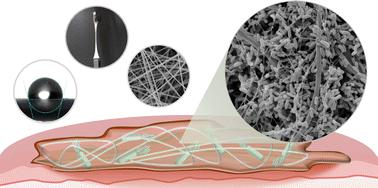当前位置:
X-MOL 学术
›
J. Mater. Chem. B
›
论文详情
Our official English website, www.x-mol.net, welcomes your
feedback! (Note: you will need to create a separate account there.)
Imitating the microenvironment of native biofilms using nanofibrous scaffolds to emulate chronic wound infections
Journal of Materials Chemistry B ( IF 6.1 ) Pub Date : 2023-03-13 , DOI: 10.1039/d2tb02700c Jana Wächter 1 , Pia K Vestweber 1 , Nathalie Jung 1 , Maike Windbergs 1
Journal of Materials Chemistry B ( IF 6.1 ) Pub Date : 2023-03-13 , DOI: 10.1039/d2tb02700c Jana Wächter 1 , Pia K Vestweber 1 , Nathalie Jung 1 , Maike Windbergs 1
Affiliation

|
Three-dimensional scaffolds of electrospun fibers are widely investigated for in vitro human tissue engineering, but to date, their application in the cultivation of bacterial biofilms has been neglected. In contrast, in a clinical setting, biofilms have received increasing recognition as major determinants of severe and chronic tissue infections, illustrating their immense threat to global public health. Their complex three-dimensional structure enables their persistence in harsh infection environments, tight attachment to human tissue and reduced susceptibility to antimicrobials. For the investigation of biofilm formation and persistence and for the development of novel infection therapies, mimicking the complex biofilm architecture with adequate in vitro models is essential. In this study, electrospun nanofibers were designed to simulate the matrix of native biofilms to serve as scaffolds for a novel biofilm model, which provides an in vivo-like growth environment and comprises biofilm–tissue interfaces. The three-dimensional scaffolds closely imitate the composition and structure of the matrix, while providing high mechanical support. The specific material properties of the developed scaffolds promote bacterial adhesion, infiltration, and homogenous distribution throughout the fiber network. Furthermore, matrix production and increased tolerance against antibiotics were proven, verifying adequate biofilm formation and maturation. In combination with human ex vivo wound models, the chronic state of infected wounds could be emulated allowing for investigation of biofilm–tissue interfaces and biofilm–host interactions. The here-described biofilm model based on nanofibers represents a valuable tool for simulating biofilm-associated infections in a pathophysiologically relevant manner paving new grounds for a multitude of possible applications beyond infection research.
中文翻译:

使用纳米纤维支架模拟天然生物膜的微环境来模拟慢性伤口感染
静电纺纤维的三维支架在体外人体组织工程中得到广泛研究,但迄今为止,它们在细菌生物膜培养中的应用一直被忽视。相比之下,在临床环境中,生物膜越来越被认为是严重和慢性组织感染的主要决定因素,这表明它们对全球公共卫生构成巨大威胁。它们复杂的三维结构使它们能够在恶劣的感染环境中持久存在,与人体组织紧密结合并降低对抗菌剂的敏感性。用于生物膜形成和持久性的研究以及新型感染疗法的开发,模拟复杂的生物膜结构具有足够的体外模型是必不可少的。在这项研究中,电纺纳米纤维被设计为模拟天然生物膜的基质,作为新型生物膜模型的支架,该模型提供类似体内的生长环境并包含生物膜-组织界面。三维支架紧密模仿基质的组成和结构,同时提供高机械支撑。开发的支架的特定材料特性促进了细菌在整个纤维网络中的粘附、渗透和均匀分布。此外,证明了基质的产生和对抗生素的耐受性增加,从而验证了足够的生物膜形成和成熟。结合人类离体伤口模型,可以模拟感染伤口的慢性状态,从而可以研究生物膜-组织界面和生物膜-宿主相互作用。这里描述的基于纳米纤维的生物膜模型代表了一种有价值的工具,用于以病理生理学相关的方式模拟生物膜相关感染,为感染研究以外的多种可能应用铺平了新的基础。
更新日期:2023-03-13
中文翻译:

使用纳米纤维支架模拟天然生物膜的微环境来模拟慢性伤口感染
静电纺纤维的三维支架在体外人体组织工程中得到广泛研究,但迄今为止,它们在细菌生物膜培养中的应用一直被忽视。相比之下,在临床环境中,生物膜越来越被认为是严重和慢性组织感染的主要决定因素,这表明它们对全球公共卫生构成巨大威胁。它们复杂的三维结构使它们能够在恶劣的感染环境中持久存在,与人体组织紧密结合并降低对抗菌剂的敏感性。用于生物膜形成和持久性的研究以及新型感染疗法的开发,模拟复杂的生物膜结构具有足够的体外模型是必不可少的。在这项研究中,电纺纳米纤维被设计为模拟天然生物膜的基质,作为新型生物膜模型的支架,该模型提供类似体内的生长环境并包含生物膜-组织界面。三维支架紧密模仿基质的组成和结构,同时提供高机械支撑。开发的支架的特定材料特性促进了细菌在整个纤维网络中的粘附、渗透和均匀分布。此外,证明了基质的产生和对抗生素的耐受性增加,从而验证了足够的生物膜形成和成熟。结合人类离体伤口模型,可以模拟感染伤口的慢性状态,从而可以研究生物膜-组织界面和生物膜-宿主相互作用。这里描述的基于纳米纤维的生物膜模型代表了一种有价值的工具,用于以病理生理学相关的方式模拟生物膜相关感染,为感染研究以外的多种可能应用铺平了新的基础。















































 京公网安备 11010802027423号
京公网安备 11010802027423号